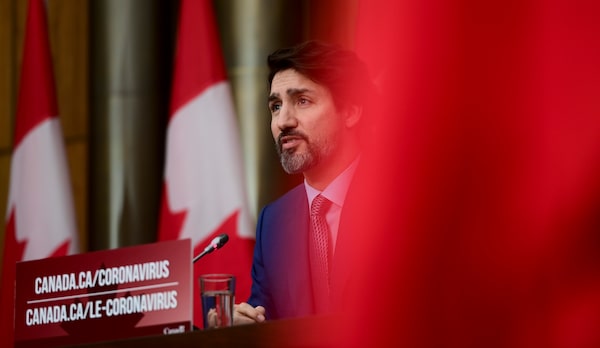
Prime Minister Justin Trudeau provides an update during a news conference in Ottawa on Nov. 17, 2020.Sean Kilpatrick/The Canadian Press
With the COVID-19 pandemic flaring up again across the country – the number of confirmed cases is now rising at almost 5,000 per day, three times its spring peak – there is a growing clamour for the federal government to step in.
What’s needed, critics agree, is some sort of national plan – a national anti-virus strategy, perhaps – in place of the “patchwork” of different approaches provincial governments have taken. Some have even urged Ottawa to invoke the Emergencies Act, giving it the power to impose its own solution.
The Prime Minister seemed to add some fuel to their case last week, urging the provinces to “do the right thing” rather than ease up on measures to control the spread of the virus. But in reality the feds are highly unlikely to intrude on provincial turf. Moreover, it’s not clear why they should.
Few would dispute that the provinces, outside of Atlantic Canada, have done an abysmal job of handling the pandemic: too slow to apply restrictions on mobility and public gatherings, too quick to relax them. But there’s no particular reason to think the federal government would do any better, just because it’s “national.”
Questions of relative competence aside, there is little about the pandemic, which varies greatly in severity from province to province and region to region, that lends itself to a one-size-fits-all “national strategy.” Most of the jurisdictional tools needed to combat it are in provincial hands, as is most of the experience in using them.
Even so, there are extra-provincial dimensions to the pandemic that suggest it cannot be left entirely to each province to solve on its own. People are still moving between provinces, for starters (again, outside Atlantic Canada), meaning the actions one province takes or does not take against the virus can potentially affect its neighbours. Moreover, it’s possible provinces have been encouraged to go too easy on the pandemic by federal support programs – the very ones Justin Trudeau pledged stood ready to help the provinces “do the right thing.” How so?
Decisions on how hard and how fast to crack down, it is often said, involve an inescapable trade-off. But it’s not the one commonly supposed – between public health and economic growth. In the long run the two are aligned: If you don’t stop the disease’s spread, even at great cost in short-run output and employment, the impact on both over time will be worse. The key words, however, are “over time.” In the short run the shutdown can seem far worse, as we saw in the spring.
The real trade-off, then, is between the short run and the long. Do too little to control the virus in the short term, and the economy will suffer in the end. But do too much – in an attempt, say, to slash the number of new cases to zero – and you will impose greater up-front costs than are required. It’s rather like the national debt: the point is not to eliminate COVID altogether, but to keep it to a manageable level.
But we are talking of the decisions of elected officials. For them the costs that matter are primarily short-run and political, while long-run economic costs can be consigned to that far-distant era when they are out of office. Getting politicians to focus on the long run is hard enough at the best of times. But when the federal government has assumed virtually all of the costs of the shutdown, short-term and long – not only bailing out workers and businesses, but potentially, the provinces themselves – premiers have little incentive to give appropriate weight to the harm that arises in future from easing restrictions today, versus the very present complaints of local businesses that they are being put out of a livelihood.
By sparing provinces the long-run costs of their actions, the federal government is not only encouraging them to take more risks with the pandemic than they might otherwise, but is adding to its own future liabilities. So Ottawa has good reason to want more influence over provincial decisions, if only to correct for its earlier, unintended influence. It may not have the jurisdictional ambit to override them, but it can still structure its assistance in ways that offer provinces incentives to take a tougher line.
That was the idea, you’ll recall, behind the Safe Reopening Agreement: in return for $19-billion in federal dough, the provinces made certain undertakings with regard to things like testing – they were supposed to be testing 200,000 people a day by now (actual figure: roughly 50,000). Any further assistance should be contingent on provinces meeting broader standards of policy stringency – and should be withheld without it.
Keep your Opinions sharp and informed. Get the Opinion newsletter. Sign up today.
 Andrew Coyne
Andrew Coyne